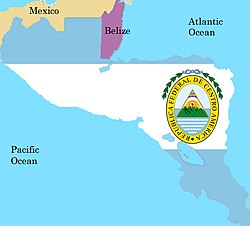Federal Republic of Central America
| Federal Republic of Central America | ||||||||||||||||||||||
| República Federal de Centroamérica | ||||||||||||||||||||||
|
||||||||||||||||||||||
|
||||||||||||||||||||||
|
Anthem La Granadera "The Song of the Grenadier" |
||||||||||||||||||||||
| Capital |
Guatemala City (1821–1834) San Salvador (1834–1838) |
|||||||||||||||||||||
| Government | Revolutionary republic | |||||||||||||||||||||
| History | ||||||||||||||||||||||
| • | Independence from Spanish Empire | September 15, 1821 | ||||||||||||||||||||
| • | Independence from First Mexican Empire | July 1, 1823 | ||||||||||||||||||||
| • | Disestablished | 1839 | ||||||||||||||||||||
| Currency | Central American Republic real | |||||||||||||||||||||
|
||||||||||||||||||||||
| Today part of |
|
|||||||||||||||||||||
The Federal Republic of Central America (Spanish: República Federal de Centroamérica), also called the United Provinces of Central America (Spanish: Provincias Unidas del Centro de América) in its first year of creation, was a sovereign state in Central America, which consisted of the territories of the former Captaincy General of Guatemala of New Spain. It existed from September 1821 to 1841, and was a republican democracy. It is also sometimes incorrectly referred to in English as the United States of Central America.
The republic consisted of the present-day states of Guatemala, El Salvador, Honduras, Nicaragua, and Costa Rica. (Panama was part of Bolivar's República de Colombia in 1821, Belize later became a British colony in 1862.) In the 1830s, an additional sixth state was added – Los Altos, with its capital in Quetzaltenango – occupying parts of what are now the western highlands of Guatemala and Chiapas state in southern Mexico. Maps and borders hardly existed at the time so locations are only approximate.
Shortly after Central America declared independence from the Spanish Empire, some of its countries were annexed by the First Mexican Empire in 1821 and then Central America formed the Federal Republic in 1823. From 1838 to 1840 the federation descended into civil war, with conservatives fighting against liberals and separatists fighting to secede. Without a sustained struggle for independence to cement a sense of national identity, the various political factions were unable to overcome their ideological differences and the federation dissolved after a series of bloody conflicts.
...
Wikipedia



